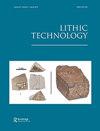Limaces and Unifaces in the Paiján Industry, Peru, and the Early Prehistory of America
IF 1.2
3区 社会学
Q2 ANTHROPOLOGY
引用次数: 2
Abstract
ABSTRACT On the coast of Peru, early human occupation is represented by the Paiján tradition. As well as the stemmed bifacial projectile points, “limaces” are characteristic of this paleo American lithic complex, in comparison with similar forms of the European Mousterian, a term that has been changed to "uniface" because of the variety of shapes in Paiján assemblages. In contrast with the Mousterian expedient technology, unifaces are highly curated tools that are discarded following repeated sequences of use and resharpening that finally render them non-functional. The discovery of a cache of two little-used unifaces in a bifacial knapping workshop shows the process of reduction to which the unifaces encountered so far have been subjected. Unifaces are generally found in the context of occupations dating from the Pleistocene-Holocene transition (Paleo-American stage) throughout America. Unifaces should be considered as one of the characteristic tool types of this stage, besides the lithic projectile points.秘鲁Paiján工业中的Limaces和Unifaces与美国早期史前史
在秘鲁海岸,早期的人类活动以Paiján传统为代表。和有茎的双面抛射点一样,“石灰”是这个古美洲石器复合体的特征,与欧洲莫斯特的类似形式相比,这个术语已经被改为“单面”,因为Paiján组合中的形状多种多样。与穆斯特的权宜技术相比,统一面是高度精心策划的工具,在重复使用和重新锐化之后,最终使它们失去功能。在一个双面夹持车间发现了两个很少使用的双面夹持,这表明了迄今为止所遇到的双面夹持所遭受的还原过程。在整个美洲,在更新世-全新世过渡时期(古美洲阶段)的职业背景下,通常可以发现单面。除了石质抛射点外,统一面应该被认为是这一阶段的特征工具类型之一。
本文章由计算机程序翻译,如有差异,请以英文原文为准。
求助全文
约1分钟内获得全文
求助全文

 求助内容:
求助内容: 应助结果提醒方式:
应助结果提醒方式:


